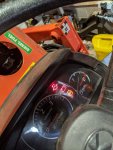torch
Well-known member
Equipment
B7100HSD, B2789, B2550, B4672, 48" cultivator, homemade FEL and Cab
The upper terminal looks bent in your picture. I wonder if that has caused an internal short?
From the B1700 service manual:
"This plug is a two-material type QGS (Quick Glow System) for quick temperature rise, and has self controlling function as well as excellent durability. The heater (4) connected in series to the heater (3), which also functions as the resistor, is incorporated in the sheath tube (1) of the super glow piug. The resistance of this heater (3) cum resistor is small when the temperature is low, while the resistance becomes large when the temperature rises.
Therefore, because sufficient current is flown to the heater (4) during the initial period of energization, the temperature rises quickly and the resistance grows with the rise in the temperature of the resistor, the flowing current is reduced to prevent the heater (4) from being heated."
There's no other resistor shown in the circuit diagrams, so it appears the glow plugs get full battery voltage.
Ohm's law says V/R=I, so:
12 volts / 1 ohm = 12 amps. 12 amps x 3 glow plugs = 36 amps.
I assume the slow-blow 30 amp fuse can tolerate a small excess for a few moments while the resistance rises. However, that one 0.8 ohm reading may be enough to push things over the edge (12V / 0.8 ohms = 15.6A), or it may indicate that the internal "heater (3)" is shorted, so the resistance never rises in that plug.
An interesting experiment, but one which would require an ammeter capable of handling at least 20 amps, would be to disconnect the wiring from all 3 glow plugs and then supply each with battery voltage through the ammeter. If the plug is working properly, one would expect to see an initial current of 12 or 13 amps, that quickly drops off as the plug heats up.
Lacking that, I would replace the suspect glow plug.
From the B1700 service manual:
"This plug is a two-material type QGS (Quick Glow System) for quick temperature rise, and has self controlling function as well as excellent durability. The heater (4) connected in series to the heater (3), which also functions as the resistor, is incorporated in the sheath tube (1) of the super glow piug. The resistance of this heater (3) cum resistor is small when the temperature is low, while the resistance becomes large when the temperature rises.
Therefore, because sufficient current is flown to the heater (4) during the initial period of energization, the temperature rises quickly and the resistance grows with the rise in the temperature of the resistor, the flowing current is reduced to prevent the heater (4) from being heated."
There's no other resistor shown in the circuit diagrams, so it appears the glow plugs get full battery voltage.
Ohm's law says V/R=I, so:
12 volts / 1 ohm = 12 amps. 12 amps x 3 glow plugs = 36 amps.
I assume the slow-blow 30 amp fuse can tolerate a small excess for a few moments while the resistance rises. However, that one 0.8 ohm reading may be enough to push things over the edge (12V / 0.8 ohms = 15.6A), or it may indicate that the internal "heater (3)" is shorted, so the resistance never rises in that plug.
An interesting experiment, but one which would require an ammeter capable of handling at least 20 amps, would be to disconnect the wiring from all 3 glow plugs and then supply each with battery voltage through the ammeter. If the plug is working properly, one would expect to see an initial current of 12 or 13 amps, that quickly drops off as the plug heats up.
Lacking that, I would replace the suspect glow plug.


